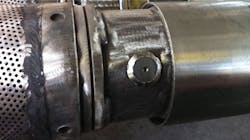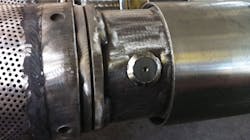Autonomous inflow control devices improve sand control
Benefits include better flow assurance and greater oil recovery
Michael Konopczynski
Tendeka Inc.
In the pursuit of additional hydrocarbon reserves and increased oil production, operators continue to look to challenging reservoirs such as high permeability, high productivity clastic reservoirs. Use of high deviation and horizontal trajectories in these wells have increased the amount of reservoir contacted by the wellbore, improving well productivity, and to some extent, reducing the potential for sand production by reducing the overall drawdown on the formation.
To ensure the integrity of the wells and prevent sand production, operators turn to a variety ofsand control methods, including gravel packs, frac packs, slotted liners and screens. A properly conceived and executed sand control strategy can be very effective in reducing or eliminating solid production without unduly restricting productivity. The effectiveness of these methods can be improved with the addition of flow control devices, such as inflow control devices and autonomous inflow control devices, which moderate and control the flow of fluids from the reservoir along the length of the wellbore. The use of these devices can improve the reliability of the sand control methods, as well as improve sweep efficiency and hydrocarbon recovery.
Causes and control
Formation sand production is a result of wellbore stress and dynamic fluid flow forces which exceed the strength of the formation and the forces which consolidate the sand grains. The potential for sand production is greatest in unconsolidated formations, where inter-granular cementation is poor or non-existent, and may be aggravated by the dissolution of sand grains and natural cementing materials by reservoir fluids, injected pressure-maintenance fluids, or stimulation fluids.
Dynamic fluid flow forces may significantly influence the onset of sand production. Pressure differentials, fluid drag forces, and overburden load combine to produce stresses that can exceed the formation shear strength and cause sand production. These forces impose stress on the sand grains, breaking their bonds with adjacent structures and transporting them into the wellbore along with the produced fluids. High fluid velocity, fluid viscosity, multi-phase flow, and dramatic flow transients can accelerate the failure of the matrix and lead to sudden increases in sand production.
Sand control strategies focus on reducing wellbore stress, improving consolidation, or transferring stress to some form of mechanical retention.
Strategies for sand control
The simplest strategy for sand control is to reduce the drawdown on the reservoir with the ultimate aim to reduce the differential pressure, production flux rate, and hence, fluid velocity. Unfortunately, this strategy is contrary to the objective of maximizing well productivity. One way of reducing drawdown and production flux rate while still maintaining high total production rate is to increase the amount of wellbore to reservoir communication. This is done by using horizontal or high deviation wells, multilateral wells, open-hole completions, under-reaming, and hydraulic fracturing. Understanding of borehole stability and formation strength is key to managing the mechanics of sand production and establishing an operation envelope of production parameters to avoid destabilizing the formation.
Mechanical sand control methods
Mechanical retention techniques rely on devices that exclude sand grains from entry into the flowing wellbore while letting fluids pass through.
Slotted liners and screens are designed to allow the majority of formation particles to “bridge” across the openings, yet offer maximum fluid flow area. Smaller formation particles are then retained behind the larger “bridged” particles. Premium screens incorporate layers of mesh, weave, or sintered metal powder matrix to handle a larger range of particle size distribution while increasing fluid flow area and providing greater mechanical strength and erosion resistance.
The proper design of slotted liner and screen sand control techniques are highly dependent on size and distribution of the formation solids produced. Slotted liners and screens can suffer from fines plugging, and destabilization of the particle bridges. In the worst case, uneven distribution of flow into the screens can create flow “hot-spots,” causing erosive “burn-through” of the slots from high velocities of fluids flowing into the wellbore. This leads to overall sand control failure and production of unacceptable quantities of sand.
Inflow control devices
Horizontal wells provide significantly greater reservoir contact in comparison to vertical wells and, as a result, can produce more oil and gas with a lower drawdown pressure along the wellbore. While long horizontal wells can increase the productivity and recovery of oil by increasing reservoir contact, uneven production due to reservoir heterogeneity, varying permeability, saturation or frictional pressure losses along the length of the horizontal bore can lead to early water or gas breakthrough in parts of the wellbore. The production of unwanted effluents negatively impacts oil flow from the rest of the well. Water influx can produce high fluid velocity and viscous drag in the formation matrix, dissolve the minerals cementing the grains, and cause an increase in sand production.
Inflow control devices (ICDs), which restrict flow by creating additional flow rate dependent pressure drops, have been used for years to balance production flux and mitigate such problems. However, they are passive in nature and, once installed, cannot be adjusted. In the event that water or gas breaks through in one part of an oil well, the passive ICD is unable to counter the effects of the higher mobility of these fluids in the reservoir, increasing flow rates and overwhelming the oil production from the well.
A relatively recent technological breakthrough in this area has been the development of autonomous inflow control devices (AICDs). These are self-regulating flow control devices that have the ability to change the amount of flow restriction based on the properties of the fluid flowing through them. Unlike passive ICDs which produce greater flow restriction for fluids with higher viscosity, the AICD can restrict water and gas more readily than oil. This ability allows for more even oil flow from all segments of the wellbore and prevents the excessive production of unwanted fluids from segments that have experienced breakthrough of water or gas. Ultimately, this capability results in greater oil recovery with a lower water cut and lower gas oil ratio.
One type of AICD, a levitating disc-based valve from Tendeka, has been deployed successfully in more than 75 wells globally with more than 15,000 valves in light and heavy oil reservoirs to overcome water or gas breakthrough and ensure uniform production. The valve, which operates through adapting to changes in fluid viscosity, preferentially restricts the flow of low viscosity unwanted water and gas while promoting the production of oil from the entire length of the well. The greater restriction of low viscosity fluid is created by the movement of the disk to create a smaller flow area through the AICD and hence, a greater flow restriction.
Both ICDs and AICDs are easily integrated with conventional screen and premium screen technology. Flow from the reservoir enters the annular area between the wellbore and screen, passes through the screen and moves in the space between the screen and the unperforated base pipe to a housing containing one or more of the flow control devices. The fluid then passes through the flow control device, entering the production conduit to surface.
Technological synergies
The use of screens with ICDs and AICDs is complementary. Screens have been used not only to prevent sand production, but also to prevent larger debris from plugging the ports and channels in the flow control devices. Careful attention to sizing of the screens ensures that whatever solids and fines are able to pass through the screens will not obstruct the ICD and AICD completion, verified by flow loop testing with solids laden fluid and slurries.
The even distribution of flow encouraged by flow control devices reduces the chance of developing flow “hot spots” which may erode screens and other completion equipment. Restriction of flow along the length of the wellbore prevents excessive velocity of fluids moving through the reservoir matrix in the near wellbore region and balances the drawdown pressure on the reservoir. These effects reduce two of the three main forces contributing to the stresses that can exceed the formation shear strength and cause sand production. Specific to AICDs, the ability to restrict the production of unwanted effluents reduces the potential for dissolution by produced water of cementing minerals in the reservoir matrix, and prevention of high drag forces from excessive fluid velocities brought on by gas break through.
Tendeka’s AICDs have been successfully deployed on the Troll field offshore Norway. The AICD is incorporated with premium screen to provide sand control and inflow control for a thin layer oil rim of between 11 to 26 m (36 to 85 ft). In the early years, passive ICDs were employed in the field, however once gas breakthrough occurred the high mobility of the gas rapidly dominated the flow in the well. A 20% increase in cumulative oil production was recorded in the AICD completion trial well within the first 18 months of production in comparison to a passive ICD equivalent.
Conclusions
AICDS are enabling production engineers to manage reservoir flow in horizontal wells with better flow assurance and greater oil recovery. The ability to restrict low viscosity unwanted water and gas results in lower water cut and reduced gas oil ratio. In addition, the synergy between AICDs and screens is a significant and beneficial method to reduce sand production caused by excessive drawdown, high fluid flow drag forces, and dissolution of cementation in poorly consolidated reservoirs.



